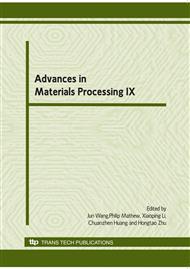p.359
p.365
p.371
p.376
p.382
p.388
p.394
p.400
p.406
Monitoring of Cutting Conditions with Dry Cutting on CNC Turning Machine
Abstract:
This paper presents the additional work of the previous research in order to verify the previously obtained cutting condition by using the different cutting tool geometries. The effects of the cutting conditions with the dry cutting are monitored to obtain the proper cutting condition for the plain carbon steel with the coated carbide tool based on the consideration of the surface roughness and the tool life. The dynamometer is employed and installed on the turret of CNC turning machine to measure the in-process cutting forces. The in-process cutting forces are used to analyze the cutting temperature, the tool wear and the surface roughness. The experimentally obtained results show that the surface roughness and the tool wear can be well explained by the in-process cutting forces. Referring to the criteria, the experimentally obtained proper cutting condition is the same with the previous research except the rake angle and the tool nose radius.
Info:
Periodical:
Pages:
382-387
Citation:
Online since:
June 2010
Keywords:
Price:
Сopyright:
© 2010 Trans Tech Publications Ltd. All Rights Reserved
Share:
Citation:


